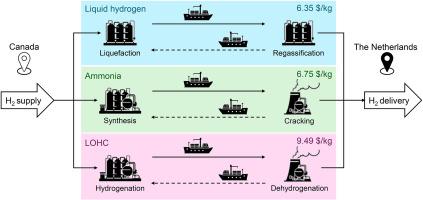Techno-economic assessment of liquid carrier methods for intercontinental shipping of hydrogen: A case study
IF 8.3
2区 工程技术
Q1 CHEMISTRY, PHYSICAL
引用次数: 0
Abstract
As global economies seek to transition to low-carbon energy systems to achieve net zero targets, hydrogen has potential to play a key role to decarbonise sectors that are unsuited to electrification or where long-term energy storage is required. Hydrogen can also assist in enabling decentralized renewable power generation to satisfy higher electricity demand to match the scale-up of electrified technologies. In this context, suitable transport, storage, and distribution networks will be essential to connect hydrogen generation and utilisation sites. This paper presents a techno-economic impact evaluation of international marine hydrogen transportation between Canada and the Netherlands, comparing liquid hydrogen, ammonia, and a dibenzyl toluene liquid organic hydrogen carrier (LOHC) as potential transport vectors. Economic costs, energy consumption and losses in each phase of the transportation system were analysed for each vector. Based on the devised scenarios, our model suggests levelised costs of hydrogen of 6.35–9.49 $2022/kgH2 and pathway efficiencies of 55.6–71.9%. While liquid hydrogen was identified as the most cost-competitive carrier, sensitivity analysis revealed a merit order for system optimisation strategies, based upon which LOHC could outperform both liquid hydrogen and ammonia in the future.

氢气洲际运输液体载体方法的技术经济评估:案例研究
随着全球各经济体努力向低碳能源系统过渡,以实现净零排放目标,氢气有可能在那些不适合电气化或需要长期能源储存的行业中发挥关键作用。氢气还能帮助分散式可再生能源发电满足更高的电力需求,以配合电气化技术的推广。在这种情况下,合适的运输、储存和分配网络对于连接氢气生产和利用场所至关重要。本文对加拿大和荷兰之间的国际海洋氢运输进行了技术经济影响评估,比较了作为潜在运输载体的液氢、氨和二苄基甲苯液态有机氢载体(LOHC)。分析了每种载体在运输系统各阶段的经济成本、能源消耗和损失。根据设计的方案,我们的模型表明氢气的平准化成本为 6.35-9.49 2022 美元/kgH2,路径效率为 55.6-71.9%。虽然液氢被认为是最具成本竞争力的载体,但敏感性分析表明了系统优化策略的优劣顺序,在此基础上,未来 LOHC 的表现可能会优于液氢和氨。
本文章由计算机程序翻译,如有差异,请以英文原文为准。
求助全文
约1分钟内获得全文
求助全文
来源期刊

International Journal of Hydrogen Energy
工程技术-环境科学
CiteScore
13.50
自引率
25.00%
发文量
3502
审稿时长
60 days
期刊介绍:
The objective of the International Journal of Hydrogen Energy is to facilitate the exchange of new ideas, technological advancements, and research findings in the field of Hydrogen Energy among scientists and engineers worldwide. This journal showcases original research, both analytical and experimental, covering various aspects of Hydrogen Energy. These include production, storage, transmission, utilization, enabling technologies, environmental impact, economic considerations, and global perspectives on hydrogen and its carriers such as NH3, CH4, alcohols, etc.
The utilization aspect encompasses various methods such as thermochemical (combustion), photochemical, electrochemical (fuel cells), and nuclear conversion of hydrogen, hydrogen isotopes, and hydrogen carriers into thermal, mechanical, and electrical energies. The applications of these energies can be found in transportation (including aerospace), industrial, commercial, and residential sectors.
 求助内容:
求助内容: 应助结果提醒方式:
应助结果提醒方式:


